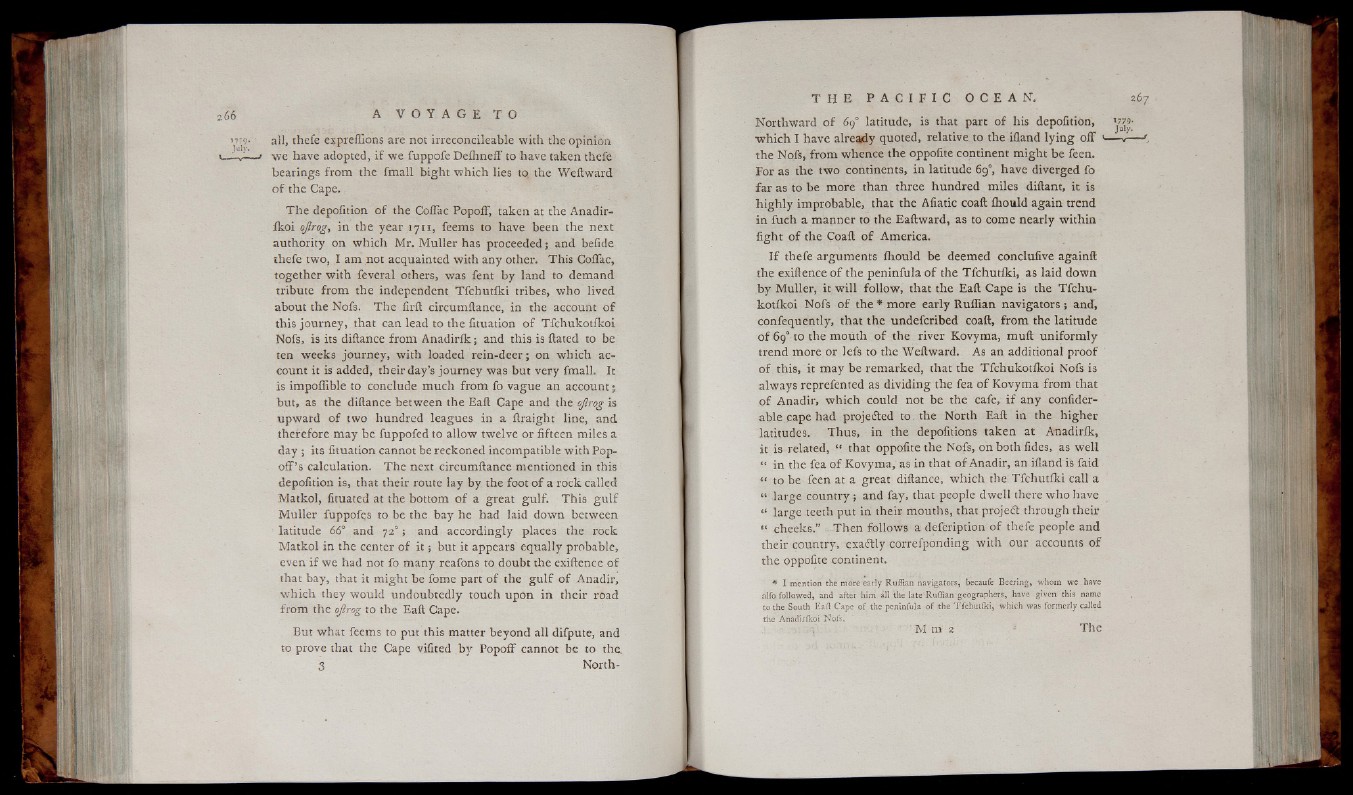
all, thefe expreffions are not irreconcileable with the opinion
we have adopted, i f we fuppofe Deihneif to have taken thefe
bearings from the fmall bight which lies to, the Weftward
o f the Cape.
T h e depoiition o f the CoiTac PopofF, taken at the Anadir-
ikoi ojlrog, in the year 17 1 1, feems to have been the next
authority on w h ich Mr. Mulle r has proceeded; and befide
thefe two, I am not acquainted with any other. This Coflac,
together with feveral others, was fent by land to demand
tribute from the independent T fchu tfki tribes, who lived
about the Nofs. T he firft circumftance, in the account o f
this journey, that can lead to the fituation o f Tfchukotlkoi
Nofs, is its diftance from A n ad ir ik ; and this is ftated to be
ten weeks journ ey, with loaded re in -d ee r; on w hich account
it is added, their day’s journey was but very fmall. It
is impoflible to conclude much from fo vague an a c cou n t;
but, as the diftance between the Eaft Cape and the ojlrog is
upward o f two hundred leagues in a ftraight line, and
therefore may be fuppofed to allow twelve or fifteen miles a
day ; its fituation cannot be reckoned incompatible with Pop-
o f f ’s calculation. The next circumftance mentioned in this
depofition is, that their route la y by the foot o f a rock called
Matkol, fituated at the bottom o f a great g u lf. This g u l f
Mulle r fuppofes to be the bay he had laid down between
latitude 66° and 72°; and accordingly places the rock
Matkol in the center o f i t ; but it appears equally probable,
even i f we had not fo many reafons to doubt the exiftence o f
that bay, that it might be fome part o f the g u l f o f A nadir,
w h ich they would undoubtedly touch upon in their road
from the ojlrog to the Eaft Cape.
But what feems to put this matter beyond all difpute, and
to prove that the Cape vifited b y PopofF cannot be to the.
3 North-
Northward o f 69° latitude, is that part o f his depofition, yw-
w h ich I have already quoted, relative to the ifland ly in g o ff 1— r—
the Nofs, from whence the oppofite continent might be feen.
For as the two continents, in latitude 69°, have diverged fo
fa r as to be more than three hundred miles diftant, it is
h ig h ly improbable, that the Afiatic coaft fhould again trend
in fuch a manner to the Eaftward, as to come nearly within
fight o f the Coaft o f America.
I f thefe arguments fhould be deemed conclufive againft
the exiftence o f the peninfula o f the Tfchutfki, as laid down
b y Muller, it w ill follow, that the Eaft Cape is the Tfchu-
kotfkoi Nofs o f the * more early Ruffian n a v ig a to r s ; and,
confequently, that the undefcribed coaft, from the latitude
o f 69° to the mouth o f the river Kovyma, muft un iformly
trend more or lefs to the Weftward. As an additional proof
o f this, it may be remarked, that the Tfchukotfkoi Nofs is
always reprefented as dividing the fea o f Kovyma from that
o f Anadir, w h ich could not be the cafe, i f any confider-
able cape had projected to . the North Eaft in the higher
latitudes. Thus, in the depofitions taken at Anadirik,
it is related, “ that oppofite the Nofs, on both fides, as w e ll
“ in the fea o f Kovyma, as in that o f Anadir, an ifland is faid
“ to be feen at a great diftance, w hich the Tfchutfki call a
“ large country ; and fay, that people dwell there who have
“ large teeth put in their mouths, that projedl through their
“ cheeks.” Then follows a defcription o f thefe people and
their country, e x a ftly correfponding with our accounts o f
the oppofite continent.
* I mention the more early Ruffian navigators, becaufe Beering, whom we have
alfo followed, and after him all the late -Ruffian-geographers, have given this name
to the South Eaft Cape of the peninfula of the Tfehutiki, which was formerly called
the Anadlrikoi NofsJ
; 1 ■ ' M in 2 - The